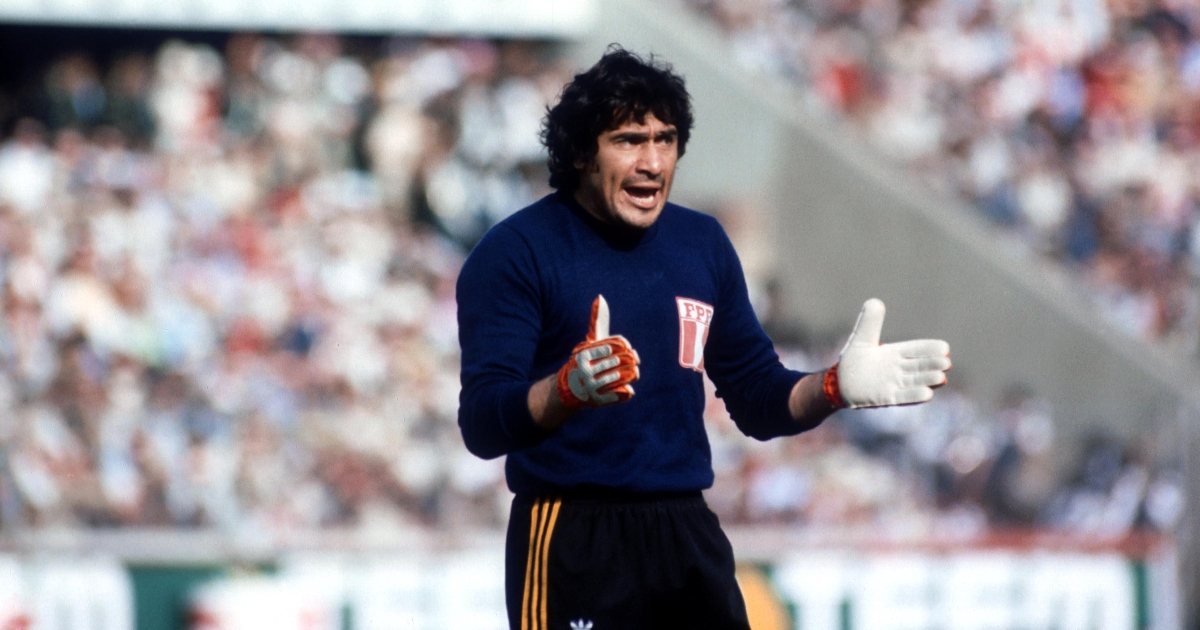Remembering 'El Loco' Ramon Quiroga and the World Cup's funniest foul
In the 1978 World Cup, Peruvian goalkeeper Ramon Quiroga, aptly nicknamed El Loco, committed the funniest foul in the history of the tournament.
It takes a certain type of footballer to earn the nickname El Loco.
The nickname was given to Martin Palermo, the Argentine striker who missed three penalties in one game and didn't give up on the spot out of shame.
That was also the case with Sebastian Abreu, a man who, having had the opportunity to send Uruguay to their first World Cup semi-final for the first time in 40 years after coming on as a substitute, converted the decisive kick with a panenka.
But the nickname is easier to maintain as an attacking player. You just need to do a quirky thing or two on the big stage and it sticks.
Besides, a bit of eccentricity in an attacker is a good thing, most of the time.
Having a guardian called El Loco, however, seems less encouraging on paper.
You see, when you select a goalkeeper known for his extravagance and unpredictability, you will get impossible saves and interceptions from time to time, as shown by Quiroga's 50 saves in six World Cup games in 1978.
You will also get things like this.
Peru had topped their group in 1978, avoiding defeat to Iran, 1974 runners-up Netherlands or self-proclaimed pre-tournament favorites Scotland.
With players like Teófilo Cubillas in such good form, even the prospect of a tough second group stage against hosts Brazil, Poland and Argentina didn't seem so daunting. It's all about momentum, right?
Well, it was definitely a matter of momentum when Quiroga flew past Poland's Grzegorz Lato, annihilating him IN THE POLISH HALF OF THE PITCH.
Crazy methodOkay, first of all, a little preamble.
Earlier in the game, the Peruvian defense presumably trusted their Argentina-born striker enough to ignore his real responsibilities, leaving Quiroga to pull off an important interception 8-10 yards from his box.
In fairness, the nonchalant reaction - calmly taking a few more touches before giving up the ball - suggests this was something he had done successfully many times before.
As the game progressed, however, Peru found themselves chasing the point they needed to stay alive in the competition.
Naturally, that meant throwing everyone forward in the closing stages, so when an attack failed and Lato was released, the goalkeeper knew exactly what he had to do.
>Again, the reaction - standing with his hands behind his back like a schoolboy who's just been caught smoking behind the bike sheds - suggests this wasn't a first for Quiroga either.
Of course, it may not have worked on this particular occasion (unless you consider a yellow card rather than a red to be proof that it "works"), but the challenging assault on Lato actually demonstrates some of the necessary qualities of a top keeper.
Let's break it down: he spots danger early and recognizes the quickest possible way to cut the angle, cutting Lato's run in half with his own, so he only has to worry about following the pace of his opponent over a short distance rather than the course of a 60-meter sprint.
He also reaches his desired position quickly enough that when the challenge is issued, he has a reasonable case for there to be defensive cover behind him. In doing so, he reinforces his argument that the card is only yellow - well done, Ramón.
And finally, after recognizing that the ball is out of his reach, he makes another calculation in a split second.
With a minute remaining, conceding a second goal will see his country eliminated for sure, while conceding a free-kick on the halfway line (even if he is sent off as a result) will keep the dream alive.
With a 40/60 chance of stopping Lato legitimately winning the ball versus a 90/10 chance of stopping it that way, he chooses the path of least resistance. This kind of quick thinking is hard to find.
Of course, Peru couldn't find that crucial goal in the end, and they sent Argentina six in their last game, but that's not the point.
He was a man who applied the expected goals model long before it became the norm in football. Quiroga wasn't just assaulting an opponent, he was actually running speed calculations - how many others can do that?
By

In the 1978 World Cup, Peruvian goalkeeper Ramon Quiroga, aptly nicknamed El Loco, committed the funniest foul in the history of the tournament.
It takes a certain type of footballer to earn the nickname El Loco.
The nickname was given to Martin Palermo, the Argentine striker who missed three penalties in one game and didn't give up on the spot out of shame.
That was also the case with Sebastian Abreu, a man who, having had the opportunity to send Uruguay to their first World Cup semi-final for the first time in 40 years after coming on as a substitute, converted the decisive kick with a panenka.
But the nickname is easier to maintain as an attacking player. You just need to do a quirky thing or two on the big stage and it sticks.
Besides, a bit of eccentricity in an attacker is a good thing, most of the time.
Having a guardian called El Loco, however, seems less encouraging on paper.
You see, when you select a goalkeeper known for his extravagance and unpredictability, you will get impossible saves and interceptions from time to time, as shown by Quiroga's 50 saves in six World Cup games in 1978.
You will also get things like this.
Peru had topped their group in 1978, avoiding defeat to Iran, 1974 runners-up Netherlands or self-proclaimed pre-tournament favorites Scotland.
With players like Teófilo Cubillas in such good form, even the prospect of a tough second group stage against hosts Brazil, Poland and Argentina didn't seem so daunting. It's all about momentum, right?
Well, it was definitely a matter of momentum when Quiroga flew past Poland's Grzegorz Lato, annihilating him IN THE POLISH HALF OF THE PITCH.
Crazy methodOkay, first of all, a little preamble.
Earlier in the game, the Peruvian defense presumably trusted their Argentina-born striker enough to ignore his real responsibilities, leaving Quiroga to pull off an important interception 8-10 yards from his box.
In fairness, the nonchalant reaction - calmly taking a few more touches before giving up the ball - suggests this was something he had done successfully many times before.
As the game progressed, however, Peru found themselves chasing the point they needed to stay alive in the competition.
Naturally, that meant throwing everyone forward in the closing stages, so when an attack failed and Lato was released, the goalkeeper knew exactly what he had to do.
>Again, the reaction - standing with his hands behind his back like a schoolboy who's just been caught smoking behind the bike sheds - suggests this wasn't a first for Quiroga either.
Of course, it may not have worked on this particular occasion (unless you consider a yellow card rather than a red to be proof that it "works"), but the challenging assault on Lato actually demonstrates some of the necessary qualities of a top keeper.
Let's break it down: he spots danger early and recognizes the quickest possible way to cut the angle, cutting Lato's run in half with his own, so he only has to worry about following the pace of his opponent over a short distance rather than the course of a 60-meter sprint.
He also reaches his desired position quickly enough that when the challenge is issued, he has a reasonable case for there to be defensive cover behind him. In doing so, he reinforces his argument that the card is only yellow - well done, Ramón.
And finally, after recognizing that the ball is out of his reach, he makes another calculation in a split second.
With a minute remaining, conceding a second goal will see his country eliminated for sure, while conceding a free-kick on the halfway line (even if he is sent off as a result) will keep the dream alive.
With a 40/60 chance of stopping Lato legitimately winning the ball versus a 90/10 chance of stopping it that way, he chooses the path of least resistance. This kind of quick thinking is hard to find.
Of course, Peru couldn't find that crucial goal in the end, and they sent Argentina six in their last game, but that's not the point.
He was a man who applied the expected goals model long before it became the norm in football. Quiroga wasn't just assaulting an opponent, he was actually running speed calculations - how many others can do that?
By
What's Your Reaction?






















